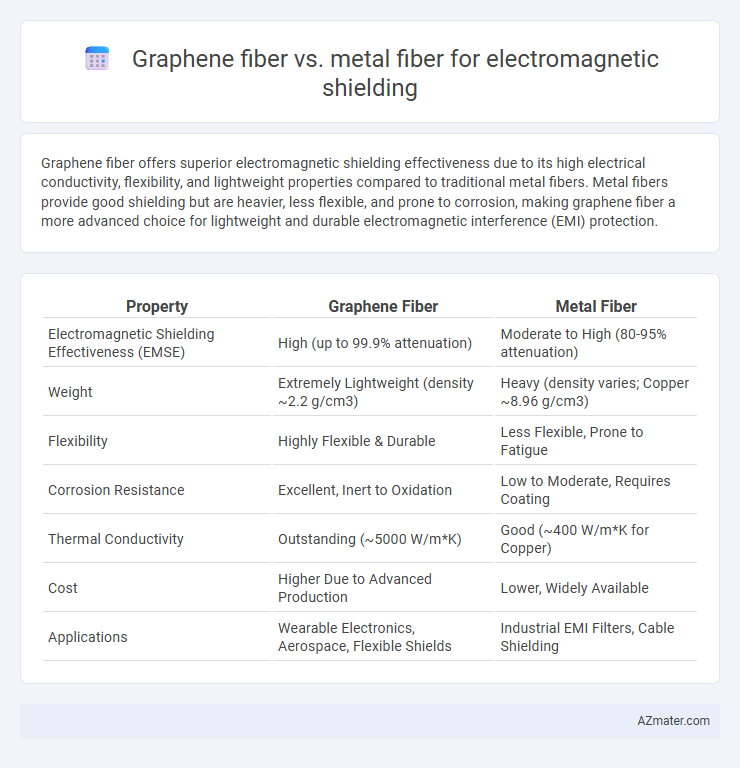Graphene fiber offers superior electromagnetic shielding effectiveness due to its high electrical conductivity, flexibility, and lightweight properties compared to traditional metal fibers. Metal fibers provide good shielding but are heavier, less flexible, and prone to corrosion, making graphene fiber a more advanced choice for lightweight and durable electromagnetic interference (EMI) protection.
Table of Comparison
| Property | Graphene Fiber | Metal Fiber |
|---|---|---|
| Electromagnetic Shielding Effectiveness (EMSE) | High (up to 99.9% attenuation) | Moderate to High (80-95% attenuation) |
| Weight | Extremely Lightweight (density ~2.2 g/cm3) | Heavy (density varies; Copper ~8.96 g/cm3) |
| Flexibility | Highly Flexible & Durable | Less Flexible, Prone to Fatigue |
| Corrosion Resistance | Excellent, Inert to Oxidation | Low to Moderate, Requires Coating |
| Thermal Conductivity | Outstanding (~5000 W/m*K) | Good (~400 W/m*K for Copper) |
| Cost | Higher Due to Advanced Production | Lower, Widely Available |
| Applications | Wearable Electronics, Aerospace, Flexible Shields | Industrial EMI Filters, Cable Shielding |
Introduction to Electromagnetic Shielding
Electromagnetic shielding is essential for protecting electronic devices from electromagnetic interference (EMI) by blocking or reducing electromagnetic field penetration. Graphene fiber offers superior electrical conductivity, lightweight characteristics, and flexibility compared to traditional metal fibers such as copper or aluminum. These properties make graphene fiber highly effective for electromagnetic shielding applications, especially in wearable electronics and aerospace industries where weight and mechanical strength are critical.
Overview of Graphene Fiber Technology
Graphene fiber technology offers exceptional electromagnetic shielding due to its superior electrical conductivity, lightweight nature, and mechanical flexibility compared to traditional metal fibers like copper and aluminum. The high surface area and excellent electron mobility in graphene fibers enhance absorption and reflection of electromagnetic waves, leading to more efficient shielding performance at reduced thickness and weight. Advanced fabrication techniques, such as chemical vapor deposition and wet-spinning, enable scalable production of graphene fibers with tunable properties tailored for electromagnetic interference (EMI) shielding applications in aerospace, wearable electronics, and telecommunications.
Properties of Metal Fiber in Shielding Applications
Metal fibers exhibit excellent electrical conductivity and high tensile strength, making them effective in electromagnetic shielding by reflecting and absorbing electromagnetic waves. Their durability and corrosion resistance ensure long-term performance in harsh environments, while their flexibility allows integration into various composites and textiles. These properties enable metal fibers to provide reliable shielding effectiveness across a broad frequency range, crucial for protecting sensitive electronic devices from electromagnetic interference.
Mechanisms of Electromagnetic Interference (EMI) Protection
Graphene fibers offer superior electromagnetic interference (EMI) protection through their high electrical conductivity and two-dimensional structure, enabling efficient absorption and dissipation of electromagnetic waves via electron hopping and interface polarization. Metal fibers shield EMI primarily by reflection and eddy current loss due to their high conductivity and magnetic permeability, effectively blocking incident electromagnetic waves. The synergistic mechanisms of absorption in graphene fibers versus reflection in metal fibers define their distinct EMI shielding effectiveness and application scopes.
Electrical Conductivity: Graphene Fiber vs Metal Fiber
Graphene fiber exhibits exceptional electrical conductivity, often exceeding that of traditional metal fibers such as copper and aluminum, making it highly efficient for electromagnetic shielding applications. Its high carrier mobility and low resistivity enable rapid electron transport, which enhances signal attenuation and reduces electromagnetic interference. Metal fibers, while conductive, often suffer from higher density and oxidation issues, limiting their performance compared to the lightweight and corrosion-resistant graphene fibers.
Structural and Mechanical Advantages
Graphene fiber offers superior tensile strength and flexibility compared to traditional metal fibers, enhancing durability and resilience in electromagnetic shielding applications. Its lightweight nature reduces structural load without compromising mechanical integrity, enabling innovative designs for wearable and flexible electronics. Metal fibers, while effective in conductivity, often suffer from brittleness and corrosion, limiting their adaptability in dynamic or lightweight shielding solutions.
Shielding Effectiveness Comparison
Graphene fiber exhibits superior electromagnetic shielding effectiveness due to its high electrical conductivity and lightweight structure, providing attenuation levels often exceeding 90 dB across a broad frequency range. Metal fibers, such as copper or silver, offer good shielding but typically suffer from higher weight and susceptibility to corrosion, which can reduce long-term performance. Studies demonstrate that graphene fibers maintain stable shielding effectiveness with enhanced flexibility, making them ideal for applications requiring durable, efficient electromagnetic interference (EMI) shielding.
Durability and Environmental Resistance
Graphene fiber demonstrates superior durability compared to metal fiber due to its exceptional tensile strength and flexibility, which reduce the risk of cracking or breaking under mechanical stress. Its chemical stability and resistance to oxidation ensure sustained electromagnetic shielding performance in harsh environmental conditions, unlike metal fibers that are prone to corrosion and degradation over time. These properties make graphene fiber a more reliable choice for long-lasting and environmentally resilient electromagnetic interference (EMI) shielding applications.
Cost and Scalability Factors
Graphene fiber offers a significant cost advantage over metal fiber due to lower raw material expenses and simplified processing techniques, making it more economically feasible for large-scale production. Its scalability is enhanced by the ability to synthesize graphene fibers through continuous wet-spinning or chemical vapor deposition methods, which can be adapted for mass manufacturing with consistent quality. In contrast, metal fibers involve higher material costs and complex fabrication processes that limit scalability and increase overall expense in electromagnetic shielding applications.
Future Prospects in EMI Shielding Materials
Graphene fiber exhibits superior electrical conductivity, lightweight properties, and flexibility compared to traditional metal fibers, making it a promising candidate for next-generation EMI shielding materials. Its exceptional surface area and tunable conductivity enable more effective attenuation of electromagnetic interference in compact, flexible devices. Ongoing research aims to enhance the scalability and durability of graphene fibers, potentially revolutionizing EMI shielding applications in aerospace, wearable electronics, and 5G communication systems.

Infographic: Graphene fiber vs Metal fiber for Electromagnetic shielding
 azmater.com
azmater.com